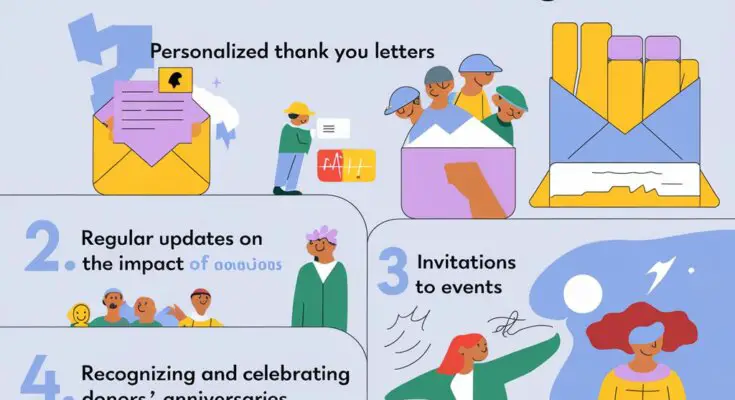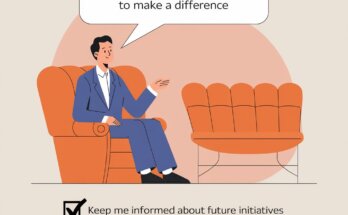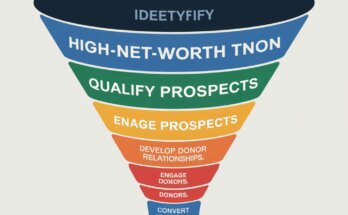In the nonprofit world, donor retention is not just a metric; it’s the lifeblood of any organization.
Nonprofits thrive on the generosity of individuals who believe in their mission, and retaining those supporters is essential for sustainability and growth.
Unfortunately, many nonprofits struggle with donor retention. They may secure initial donations, but often fail to convert those one-time gifts into lasting relationships.
In this post, we’ll explore effective nonprofit donor retention strategies that can help you keep your supporters engaged and committed to your cause.
The Importance of Donor Retention
Did you know that it costs five times more to acquire a new donor than to retain an existing one? That’s a staggering statistic that emphasizes the importance of focusing on donor retention.
When you retain donors, you not only save money but also foster a community of committed individuals who can help amplify your message, increase your visibility, and inspire others to give.
Strategy 1: Build Personal Relationships
One of the most effective ways to ensure donor retention is by building personal relationships with your donors. It’s not just about sending a thank-you email after receiving a donation; it’s about cultivating a genuine connection.
Example: Consider implementing a system where your team reaches out personally to donors.
For instance, if a donor has given multiple times, a personalized phone call or handwritten note expressing gratitude can make a significant impact.
Take the story of a small animal shelter that struggled with donor retention. They began sending personalized updates about the animals their donors helped rescue.
This simple act of communication transformed their relationships and led to a 40% increase in repeat donations.
Tips for Building Personal Relationships:
- Use donor data to personalize communication (e.g., addressing donors by their first name).
- Share stories that resonate with your donors and showcase the impact of their contributions.
- Celebrate milestones with your donors, such as anniversaries of their first donation.
Strategy 2: Develop a Donor Stewardship Plan
A donor stewardship plan outlines how you will acknowledge and engage your donors over time. It’s a structured approach to nurturing relationships, ensuring that donors feel valued and connected to your mission.
Example: A nonprofit that focuses on education created a donor stewardship plan that included quarterly updates, invitations to exclusive events, and opportunities for donors to engage directly with beneficiaries. By consistently communicating with their donors and making them feel involved, they saw their retention rates soar from 55% to 75% in just two years.
Elements of a Successful Donor Stewardship Plan:
- Acknowledge donations promptly and authentically.
- Provide regular updates on how donations are being used.
- Create opportunities for donors to engage with your organization, such as volunteering or attending events.
Strategy 3: Create Impact Reports
Donors want to see the impact of their contributions. Providing them with regular updates on how their money is being spent and the results achieved can significantly enhance donor retention.
Example: A nonprofit dedicated to environmental conservation started sending out annual impact reports that highlighted their achievements, including the number of trees planted and wildlife rescued. These reports were visually appealing and filled with stories of real people affected by their work. As a result, they noticed a 60% increase in donor renewals after implementing this strategy.
Tips for Creating Impact Reports:
- Use engaging visuals and infographics to present data clearly.
- Include testimonials from beneficiaries to humanize the impact.
- Ensure that the reports are easily accessible, such as via email or on your website.
Strategy 4: Foster a Sense of Community
Creating a sense of community among your donors can foster loyalty and increase retention rates. When donors feel like they are part of something bigger, they are more likely to stay engaged.
Example: A local food bank launched a monthly donor club that offered exclusive events, behind-the-scenes tours, and opportunities to meet fellow donors. This initiative not only strengthened relationships among donors but also led to a 50% increase in monthly giving.
Ways to Foster Community:
- Host donor appreciation events where supporters can meet and connect.
- Create online forums or social media groups where donors can share their experiences and stay updated on your organization’s activities.
- Encourage donors to share their stories and experiences related to your cause.
Strategy 5: Offer Multiple Giving Options
Flexibility in giving can enhance donor satisfaction and retention. Not all donors have the same preferences when it comes to making contributions, so providing multiple giving options can make it easier for them to support your organization.
Example: A nonprofit dedicated to health awareness offered various giving methods, including one-time donations, monthly subscriptions, and even in-kind donations. They provided clear instructions for each method and highlighted the benefits of sustained giving. This approach resulted in a diverse funding base and improved retention rates, with 70% of monthly donors continuing their contributions beyond the first year.
Ideas for Giving Options:
- Set up online donation forms that allow donors to choose how much and how often they give.
- Consider offering legacy giving options for supporters who may want to leave a lasting impact.
- Promote matching gift programs, where donors can double their contributions through their employers.
Strategy 6: Engage Donors Through Storytelling
Storytelling is a powerful tool for engaging donors and keeping them connected to your mission. When donors hear stories that resonate with them, they are more likely to feel a personal connection and stay committed.
Example: A nonprofit focused on youth mentorship shared stories of young individuals who had overcome challenges thanks to their programs. They created videos featuring these success stories, which were shared across social media and newsletters. This emotional connection led to an uptick in donations and a 30% increase in donor retention.
Tips for Effective Storytelling:
- Highlight the personal journeys of beneficiaries to evoke empathy and connection.
- Use diverse formats, such as videos, blog posts, or social media updates, to share stories.
- Always tie back the stories to the impact donors have made through their contributions.
A Relatable Story: The Journey of Hope
Let me share a heartfelt story that encapsulates the essence of donor retention. Meet Sarah, a devoted supporter of a nonprofit focused on helping women escape domestic violence. Sarah started giving small amounts each month after attending an awareness event. She was moved by the testimonials shared and felt compelled to contribute.
However, after a year of giving, Sarah became disengaged. She didn’t receive any updates on the impact of her contributions, nor did she feel connected to the organization. It wasn’t until the nonprofit launched a donor stewardship plan that everything changed.
Through personalized emails and quarterly impact reports detailing the success stories of women they helped, Sarah reignited her passion for the cause. She felt valued and recognized, leading her to increase her monthly donations. Sarah eventually became an ambassador for the organization, sharing their mission within her community and encouraging others to support them.
Sarah’s journey highlights the critical importance of maintaining relationships with donors. When nonprofits take the time to acknowledge and engage their supporters, they can transform one-time donors into lifelong advocates.
Strategy 7: Ask for Feedback
Donors appreciate being heard. Asking for their feedback not only shows that you value their opinion but also provides insights on how you can improve your engagement strategies.
Example: A nonprofit focusing on arts education sent out annual surveys to their donors, asking for feedback on events, communication, and their overall experience with the organization. Based on the feedback, they made adjustments, such as enhancing their event experiences and increasing communication frequency. This proactive approach led to a 25% increase in donor satisfaction and retention.
How to Gather Feedback:
- Send out surveys via email or social media.
- Host focus groups or informal gatherings to discuss donor experiences.
- Use feedback to make tangible changes and communicate these improvements back to donors.
Strategy 8: Utilize Technology for Engagement
In today’s digital age, technology can be a game-changer for donor retention. Using tools to automate communication, track donor interactions, and provide personalized experiences can significantly enhance your efforts.
Example: A nonprofit dedicated to wildlife conservation implemented a donor management system that allowed them to track donor interactions and tailor communications based on individual preferences. By automating follow-up emails and reminders for upcoming events, they improved their donor engagement and saw retention rates rise by 40%.
Tech Tools to Consider:
- CRM (Customer Relationship Management) systems for tracking donor interactions.
- Email marketing software to send personalized messages and updates.
- Social media management tools to engage with supporters and share stories effectively.
Strategy 9: Host Special Events
Special events are a great way to engage your donors and provide them with an immersive experience related to your cause. These gatherings can help reinforce the connection between your organization and its supporters.
Example: A nonprofit focused on mental health organized a “Walk for Wellness” event. They invited donors to participate, sharing stories from individuals benefiting from their programs during the event. The atmosphere was filled with enthusiasm and support, leading to an increase in donor participation and a 50% rise in contributions after the event.
Tips for Hosting Successful Events:
- Choose a theme that aligns with your mission and engages donors emotionally.
- Promote the event extensively through social media, emails, and community outreach.
- Offer exclusive opportunities for attendees, such as meet-and-greets with beneficiaries or behind-the-scenes tours.
Conclusion
Implementing effective nonprofit donor retention strategies is essential for ensuring your organization’s sustainability and growth.
Donor retention is not just about maintaining numbers; it’s about creating a community of passionate individuals committed to your cause. By implementing these strategies, you can turn one-time donors into lifelong advocates who will support your organization for years to come.
For more expert tips and resources on donor retention and nonprofit management, be sure to subscribe to the Nonprofit Navigators Newsletter. Plus, don’t forget to download, Top 10 Donor Stewardship Strategies for Nonprofits + Free Donor Engagement Checklist, to get started on your journey to better donor retention today!
Let’s work together to make a lasting impact in our communities. Your efforts can lead to transformative change, and every donor you retain is a step toward a brighter future for your organization.




